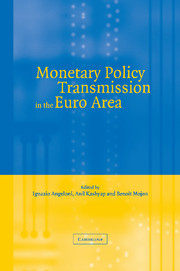 Monetary Policy Transmission in the Euro Area
Monetary Policy Transmission in the Euro Area Book contents
- Frontmatter
- Contents
- List of contributors
- Foreword by O. Issing
- Acknowledgements
- List of abbreviations
- Introduction
- Part 1 Macroeconometric evidence on the transmission mechanism in the euro area
- Part 2 Firms' investment and monetary policy: evidence from microeconomic data
- Part 3 The role of banks in the transmission: evidence from microeconomic data
- 14 Financial systems and the role of banks in monetary policy transmission in the euro area
- 15 The reaction of bank lending to monetary policy measures in Germany
- 16 Is there a bank-lending channel of monetary policy in Spain?
- 17 Is there a bank-lending channel in France? Evidence from bank panel data
- 18 Is there a bank-lending channel of monetary policy in Greece? Evidence from bank-level data
- 19 The Italian banking system and monetary policy transmission: evidence from bank-level data
- 20 The impact of monetary policy on bank lending in the Netherlands
- 21 The cross-sectional and the time dimension of the bank-lending channel: the Austrian case
- 22 The bank-lending channel of monetary policy: identification and estimation using Portuguese micro bank data
- 23 Transmission of monetary policy shocks in Finland: evidence from bank-level data on loans
- Part 4 Monetary policy in the euro area: summary and discussion of the main findings
- Appendix
- References
- List of figures
- List of tables
- Subject index
- Author index
16 - Is there a bank-lending channel of monetary policy in Spain?
Published online by Cambridge University Press: 22 September 2009
- Frontmatter
- Contents
- List of contributors
- Foreword by O. Issing
- Acknowledgements
- List of abbreviations
- Introduction
- Part 1 Macroeconometric evidence on the transmission mechanism in the euro area
- Part 2 Firms' investment and monetary policy: evidence from microeconomic data
- Part 3 The role of banks in the transmission: evidence from microeconomic data
- 14 Financial systems and the role of banks in monetary policy transmission in the euro area
- 15 The reaction of bank lending to monetary policy measures in Germany
- 16 Is there a bank-lending channel of monetary policy in Spain?
- 17 Is there a bank-lending channel in France? Evidence from bank panel data
- 18 Is there a bank-lending channel of monetary policy in Greece? Evidence from bank-level data
- 19 The Italian banking system and monetary policy transmission: evidence from bank-level data
- 20 The impact of monetary policy on bank lending in the Netherlands
- 21 The cross-sectional and the time dimension of the bank-lending channel: the Austrian case
- 22 The bank-lending channel of monetary policy: identification and estimation using Portuguese micro bank data
- 23 Transmission of monetary policy shocks in Finland: evidence from bank-level data on loans
- Part 4 Monetary policy in the euro area: summary and discussion of the main findings
- Appendix
- References
- List of figures
- List of tables
- Subject index
- Author index
Summary
Introduction
This chapter explores the response of bank-loan supply to monetary policy changes in Spain. Results in Ehrmann et al. (chapter 14 in this volume) show that, after a tightening in monetary policy, those Spanish banks with less liquid assets, relative to total assets, reduce their loan growth by more than more liquid banks, whereas no difference is found in the response of big and small banks and well- and poorly capitalised banks. Under the usual assumption that more and less liquid banks face the same loan demand function, this differential response can be interpreted as a loan-supply movement, implying the existence of a bank-lending channel of monetary policy transmission in Spain.
However, in the case of Spain, because of the important differences in the composition of bank lending, the differential response across banks may be reflecting either a genuine difference in loan-supply behaviour or a difference induced by the diverse demand-side behaviour of the different types of loans. Moreover, since monetary policy affects both loan supply and loan demand, all tests based on monetary policy shocks are potentially subject to the criticism of not having controlled adequately for differences in loan demand. Fortunately, we have, in the Spanish case, a significant exogenous shock to bank deposits, arising from the tax-induced development of mutual funds during the 1990s, that permits us to carry out an experiment to check whether bank-loan supply is affected by changes in the availability of deposits.
- Type
- Chapter
- Information
- Monetary Policy Transmission in the Euro AreaA Study by the Eurosystem Monetary Transmission Network, pp. 284 - 296Publisher: Cambridge University PressPrint publication year: 2003
- 11
- Cited by
